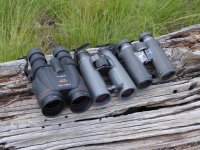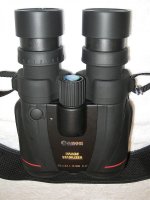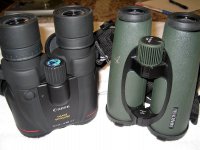Greetings Chuck,
The big plus of the Canon 10X42 L IS is the image stabilization. It really works! I have a couple of Canon IS models (the 15X50 for several years and more recently the 10X42) and I still get a big kick out them every time I press the IS button and the image becomes near rock solid. The technology is quite impressive but so is the improvement in the view with the noticeable reduction in shake.
Another notable plus is the optical quality. The 10X42L IS uses Canon's L series lenses and the optical quality is top notch. It also has a very generous center view (I think it may use lens flatteners), the FOV of approximately 340 ft is right up there with the alphas, and it has a small Porro effect.
It does have electronics and moving parts for the stabilization that makes it more susceptible to damage, but it looks to me to be well built.
Considering this binocular has alpha quality optics for hundreds of dollars less than the alphas, it seems like a real bargain to me, and this is before factoring in the image stabilization technology.
Now for the potential down sides.
It is heavy and it is bulky, although despite the weight, it is well balanced and holds well. As Ted has mentioned, it has a steady hold even without the image stabilization on. It will get heavy around the neck so a harness may be best for a long outing.
The body does not pivot for the IPD adjustment as in a conventional binocular. Instead the body is solid and square like. It does not have a natural hold to me and in some ways, it feels like holding a small fat book. Whether that is an issue will vary between individuals. I am aware of the difference but have no problem adapting.
What is interesting is that first few times using it, the immediate instinct is to try and bend/pivot the body to adjust the IPD. After a few days I got out of the habit of trying to do that. I guess I am a creature of habit. :king:
The IPD is actually done by moving the eye pieces. It works but it is more awkward than a conventional binocular. Even so, it is not a big deal and does get the job done. I do not consider it an issue since the IPD is basically a set it once and forget it operation.
A good thing about the 10X42 is it has screw up eye cups compared to some of the other Canon models. Even so, they just are not that comfortable for me. I find eye placement and fit a little more difficult then my other conventional 10X42 models. It is just ever so slightly annoying but not anywhere near a show stopper.
One side note about the eye cups. They extend out more so than most in relationship to the eye relief. It is the only binocular I have where I am one click less than full extension. I look at this as a good thing since there are so many models where the eye cups are to short in relationship to the eye relief and there is no easy way to adjust for that. I have no experience using the Canon with eye glasses, so I will let other folks comment on that.
The Canon 10X42 has a diopter adjustment ring as part of the right eye piece. Adjusting it turns the whole eye piece which I find inferior since it rubs against the skin making the adjustment more difficult. However this is generally just a one time adjustment so it is no big deal.
What is a bigger deal is the ring has a lock by pushing the ring toward the eye piece end. What is unfortunate (at least in my unit) is the friction is almost non existent and the ring slides back to the unlocked position and I end up inadvertently resetting the diopter to a different setting. Again, it is not a big deal because I am now in the habit of checking the setting and can easily rotate it to the proper position, but it is an annoyance.
For reasons I do not understand, I do find myself doing slightly more searching when trying to lock on to the sharpest focus. There are some posts about a shimmer effect related to the IS system so that my be what is coming into play, but I do not fully understand what it is about. This is really minor and is not a problem for me, but it may be for some so I am mentioning it.
The view from the Canon is fantastic but I am more aware of the fact that I am using a binocular than I am when viewing with the Zeiss SF 10X42. The SF seems like a more natural view to me I think due to several factors. One is the balance and feel, another is the more comfortable eye cups, also I am able to more easily lock onto focus and then there is the exceptional wide FOV of the SF. Again, this is not to be considered a major criticism, but just something to be aware of. Also, this my be more of a personal preference conclusion then anything repeatable between individuals.
The last thing to keep in mind is it is an electronic instrument and is more subject to failure (meaning the IS function) than a conventional binocular. However, the reviews on reliability have been good overall and I feel it is worth the risk to get the benefits of image stabilization. If one takes good care of their equipment, then I think the risk of premature failure are minimal. However, it would not be the best choice for someone who is rough on equipment or who will be using it in a rough and tumble environment. I suspect there will eventually be a failure, but it will be after years of use and so the owner should have plenty of time to get their money's worth out of the Canon.
I look at the Canon 10X42 L IS as more of a specialty binocular rather than a primary use binocular. It is not my first choice for everyday use. I primarily use it for shorter outings where the weight will not become overbearing as the day goes on or the other quirks do not have time to build up over the day.
There are several members who successfully use their Canon as their primary binocular, so my comments of it being a specialty unit are most definitely a personal preference conclusion. Everyone will have to make their own judgment on the pros and cons and then decide if the Canon works for them.
One thing fun is to use it in a vehicle as a passenger when driving down the road. It is helpful in spotting cop cars at a distance! It is far from rock steady in a moving vehicle but it works much better than looking though a conventional 10X.
Even though it has it's list of quirks, I really like the Canon 10X42. All those little annoyances just go away when you press the IS button. I am happy that I have it and I have no intentions of selling it any time soon.
Chuck ... I read all of your posts and have a good idea of what you like. Actually, we have a good overlap of models. I believe you are an enthusiast and appreciate a binocular for being more than just a tool. If I am correct, I think you would really enjoy having the Canon. It is unique and a joy to use under the right conditions.
Here are some comparision photos that you requested. Please note that my Canon has after market lens shades attached to the objectives so that makes the binocular look longer than it is from Canon. The lens shades not only look cool, but they help protect the objective lenses from damage. I do not think they are needed for stray light control.. Since the objectives are threaded, you can also add UV or polarizer filters. (The Nikon EDG-II 10X42 is for all practical purposes comparable in size and appearance to your 8X42 EDG-II.)
Zeiss SF 10X42, Zeiss HT 8X42, Nikon EDG-II 10X42
Canon 10X42 L IS and a Bushell Elite ED 10X42 ......
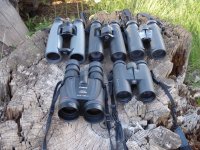
Canon 10X42 L IS and a Zeiss SF 10X42 ......
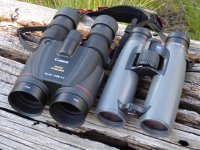
Canon 10X42 L IS, Zeiss SF 10X42, Nikon EDG-II 10X42 ......
